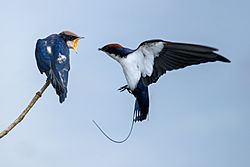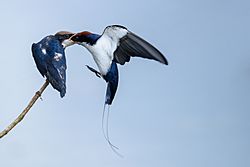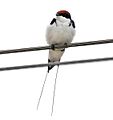Swallow facts for kids
Quick facts for kids Swallows |
|
|---|---|
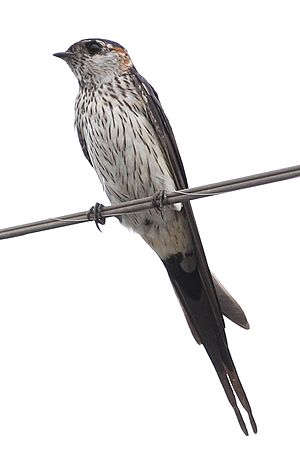 |
|
| Red-rumped Swallow | |
| Scientific classification | |
| Kingdom: | |
| Phylum: | |
| Class: | |
| Order: | |
| Suborder: | |
| Family: |
Hirundinidae
Vigors, 1825
|
Swallows and martins are a group of passerine birds. They belong to the family Hirundinidae. These birds are special because they are great at catching insects while flying. In Europe, people often use "swallow" to mean the Barn Swallow.
The names "martin" and "swallow" are used for different types of these birds. "Martin" usually refers to species with squarer tails. "Swallow" is often used for those with more fork-shaped tails. But scientifically, there is no real difference between them. This bird family has about 83 different species in 19 groups (genera).
Contents
What Swallows Look Like
Swallows have a special body shape that helps them fly and hunt. Their bodies are slim and smooth. They have long, pointed wings. This design helps them move easily and fly for a long time. It also lets them glide often. Their body shape makes their flight very efficient. They use much less energy flying than other birds their size.

Swallows have very good eyesight. This helps them spot and follow insects in the air. Their eyes are shaped in a way that gives them sharp vision, similar to birds of prey.
Like swifts, which also catch insects in the air, swallows have short bills. But they have strong jaws and a wide mouth. This helps them scoop up insects. Swallows are usually between 10 to 24 centimeters (4 to 9 inches) long. They weigh about 10 to 60 grams (0.3 to 2 ounces). Their wings are long and pointed. Their tails have 12 feathers and can be deeply forked, slightly curved, or square. A long tail helps them steer better. It can also be a way for males to attract females. For example, male barn swallows have tails that are 18% longer than females. Females often choose mates based on tail length.
Their legs are short. Their feet are made for perching on branches, not for walking much. Swallows can walk or run, but they waddle. Some types, like the river martins, have stronger leg muscles. River martins also have other differences. Their bills are orange-red, and their legs and feet are pink. Most other swallows have dark brown or black bills, legs, and feet.
Most swallows have shiny dark blue or green feathers on their backs. Their bellies are often plain white or streaked with colors like red-brown. Species that live in burrows or dry, rocky areas are often dull brown on top. Male and female swallows look very similar. Males might have slightly longer outer tail feathers. Baby swallows hatch without feathers and with their eyes closed. Young birds usually look like duller versions of the adults.
Where Swallows Live
Swallows live almost everywhere in the world. They breed on every continent except Antarctica. Some species, like the Pacific swallow, live on many islands in the Pacific Ocean. The Mascarene martin lives on islands in the Indian Ocean. Many swallows are migratory birds. This means they travel long distances. The barn swallow, for example, breeds in most of the Northern Hemisphere. It then flies south for the winter.
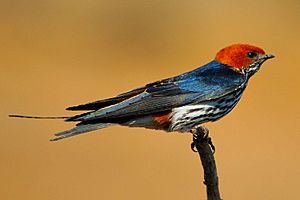
Swallows live in many different places. They need flying insects to eat. So, they often feed near rivers and lakes. But they can be found in any open area. This includes grasslands, open forests, savannas, and wetlands. They live from sea level up to high mountains. Many swallows also live in places changed by humans. This includes farms and cities. Changes in land use have helped some species spread. The welcome swallow is a good example. It started living in New Zealand in the 1920s. Now, it is a common bird there.
Swallows that breed in cooler areas fly south for the winter. This is because their insect food disappears when it gets cold. Swallows in warmer areas often stay in one place. But some tropical species also migrate short distances. Long ago, people thought swallows might hibernate underwater in winter. This idea was even considered by smart observers like Gilbert White. This might have happened because some swallows gather in large groups in shelters during bad weather. Some species can even go into a state of torpor to save energy. This is like a deep sleep. The first time scientists confirmed a swallow going into torpor was in 1988 with house martins.
Swallow Behavior and Life
Swallows are amazing flyers. They use their flying skills to find food and attract a mate. Some species, like the mangrove swallow, protect their own area (territory). Others do not, and only defend their nest. Usually, the male chooses a nest spot. Then, he attracts a female with his song and flight. He also guards his territory. The size of the territory depends on the species. For birds that nest in groups, the territory is small. For birds that nest alone, it can be much bigger.
Outside the breeding season, some swallows form large groups. They also sleep together in big roosts. This helps protect them from predators like sparrowhawks and hobbies. These roosts can be huge. One winter roost of barn swallows in Nigeria had 1.5 million birds! If a person gets too close to their nest, swallows will attack. Birds in colonies might mob (attack in a group) predators or humans near their colony.
What Swallows Eat
Most swallows eat insects they catch while flying. They eat many different kinds of insects. What they eat depends on the species and the time of year. Swallows are picky eaters. They don't just eat any insect. They choose bigger ones. How easy an insect is to catch also affects if swallows eat it. They also avoid certain insects, like stinging bees and wasps.
Besides insects, some swallows occasionally eat fruits or other plant matter. Swallows in Africa have been seen eating seeds from Acacia trees. They even feed these seeds to their young.
Swallows usually catch prey while flying. But sometimes, they will grab insects off branches or the ground. Their flight can be fast with quick turns when chasing speedy prey. For slower prey, they might fly slower, circling and gliding. When different swallow species feed together, they often stay at different heights. Some feed closer to the ground, while others fly higher. This helps them share the food without competing too much.
Swallow Reproduction
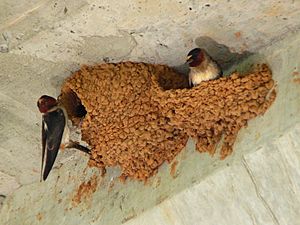
Some swallows nest in existing holes, like old woodpecker nests. Other species dig burrows in soft ground, like sand banks. Swallows in certain groups (like Hirundo and Petrochelidon) build nests out of mud. They build these nests under shelter, safe from weather and predators. Mud nests are common in the Old World, especially Africa. Birds that nest in holes are more common in the New World. Mud nests can crumble in very humid places. Many swallows that live in caves, banks, or cliffs nest in large groups (colonies). Both male and female swallows help build mud nests. If they dig tunnels, they share that work too. In the past, human-made stone buildings like barns and bridges helped swallows find more places to nest. This has helped some species spread to new areas. Birds living in big colonies sometimes have problems with parasites and other birds laying eggs in their nests.
Pairs of swallows usually stay together (monogamous). If they don't migrate, they often stay near their breeding area all year. But they protect their nest most strongly during breeding season. Migratory swallows often return to the same breeding area each year. They might even use the same nest if it worked well before. Young birds usually choose a nest site close to where they were born. Swallows in cooler areas breed at certain times of the year. In warmer areas, they might breed all year or at specific times. Breeding usually happens when there are lots of insects, often during the wet season. But some, like the white-bibbed swallow, nest in the dry season to avoid floods. All swallows protect their nests from animals that eat eggs. Solitary species are more aggressive than colonial ones. Male swallows help care for their young more than most other passerine birds.
Swallow eggs are usually white. But some mud-nesting species have speckled eggs. They usually lay about four to five eggs in cooler areas. In warmer areas, they lay two to three eggs. Both parents might take turns sitting on the eggs (incubation). In some species, only the female incubates. Even if the male doesn't incubate, he might sit on the eggs to keep them warm when the female is away. Incubation periods last 5–15 minutes. Then, the parent goes to find food. Swallow eggs usually hatch in 10–21 days, most often 14–18 days.
Baby swallows hatch without feathers and with their eyes closed. Their eyes don't fully open for up to 10 days. Feathers start to grow after a few days. Parents keep the chicks warm until they can control their own body temperature. Baby swallows grow slowly compared to other passerine birds. Parents usually feed the chicks a ball of many insects, not just one. No matter if the male helps incubate or keep the chicks warm, all male swallows help feed the babies. It's hard to tell exactly when young swallows leave the nest. Parents encourage them to leave after three weeks. But they often come back to the nest to sleep.
Images for kids
-
The Bahama swallow is listed as an endangered species
-
An artificial purple martin nesting colony
-
Wire-tailed swallow, Hirundo smithii
See also
 In Spanish: Hirundínidos para niños
In Spanish: Hirundínidos para niños


